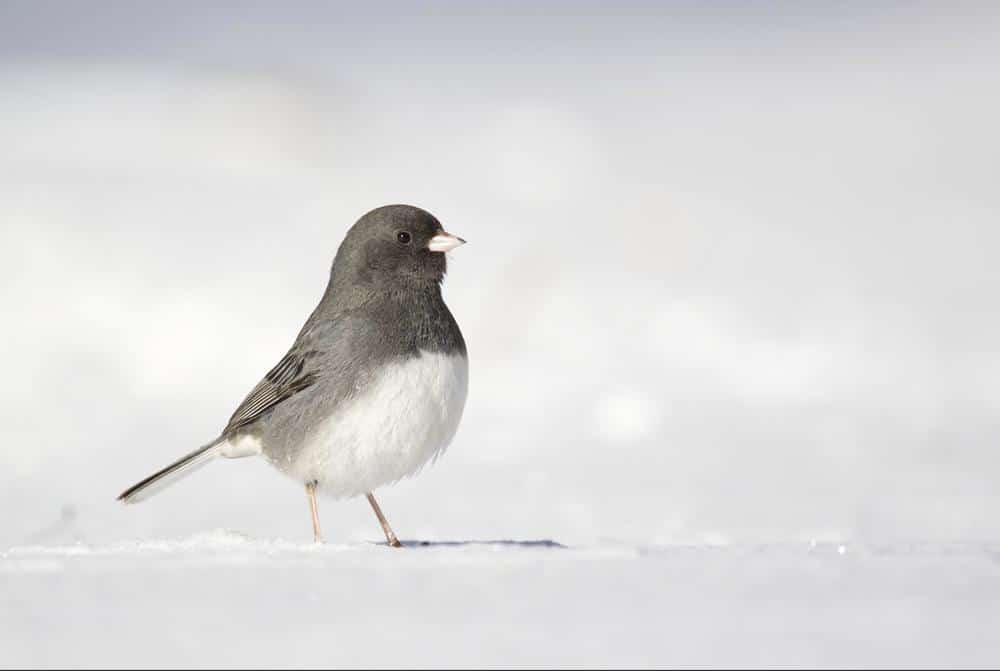Travel
BIRD: At 25, Backyard Bird Count Shows Power Of Citizen Science

Steve and Janet Kistler of Hart County, Kentucky, will definitely take part in the Great Backyard Bird Count when it starts on Friday. Since the now-global tradition began 25 years ago, they have done so yearly.
This will be the first count for Moira Dalibor, a middle-school math teacher in Lexington a couple of hours away. She’s leading a group of students and parents to a nursery for a data-gathering exercise.
They’ll be among hundreds of thousands of people worldwide, counting and recording over four days. The Great Backyard Bird Count, or GBBC, was completed by approximately 385,000 people from 192 countries last year.
“Every year, we see increased participation,” says Becca Rodomsky-Bish, project leader at the Cornell Lab of Ornithology in Ithaca, New York, which organizes the count with the National Audubon Society and Birds Canada.
Tens of thousands of people submitted checklists in India, which had the highest participation outside of the United States last year — a 28% increase from 2021.
This global data is fed into the eBird database, which scientists use to research bird populations, which have declined dramatically in recent decades. It’s part of a growing trend of “citizen science” projects in which volunteers gather data about the natural world for researchers to use.
And, according to Steve Kistler, the more people interested in bird watching, the better.
Many Watchers Use eBird
“It’s fun and important to get the numbers, but it’s just a joyful thing to do,” says Kistler, who leads watching trips locally and internationally.
Many bird watchers use eBird all year, and it has amassed massive amounts of data — often between 1 million and 2 million bird checklists per month from around the world in the last few years, according to Rodomsky-Bish.
These figures assist researchers in tracking the ups and downs of various species, which aids in determining the direction of conservation efforts.
“We’re losing the net number of birds worldwide,” says Rodomsky-Bish.
Cornell University researchers discovered 3 billion fewer birds in North America in 2019 than in 1970.
“The bad news is that the declines in the data are coming out strong and hard,” Rodomsky-Bish adds. “The good news is that we wouldn’t know if we didn’t have that data. And this enables many areas to take direct action.”
According to her, the pandemic contributed to the increased interest in the GBBC and birds in general.
“Birds were company during this period of isolation,” she says, and observing them “is an accessible way to connect with the natural world. There are flyers everywhere. You are not required to leave your home. They will arrive… They’re also charming. They’re entertaining and fascinating to watch.”
Birds were company during this period of isolation
Compared to other counts, such as Audubon’s 123-year-old Christmas Bird Count and the Cornell Lab’s Project FeederWatch, the GBBC is user-friendly.
How it works: Participants observe birds by looking out the window for 15 minutes or traveling to a nature preserve. Organizers recommend the Merlin bird ID app for distinguishing birds based on size, shape, song, or other characteristics. Along with their phones, many participants carry field guides and binoculars.
They then enter their discoveries into the eBird app.
“‘I can contribute to science — it’s simple,’ anyone can say. “If I can identify one bird in four days, I’ve done my job,” says Rodomsky-Bish.
She says that counting in February gives a good picture of the situation before many birds start their yearly spring migrations.
Dalibor, who teaches at the Redwood Cooperative School in Kentucky, has been learning how to use the Merlin app and researching local species. The children will use pencils and clipboards to record bird sightings, and parent volunteers will enter those numbers into phones.
“It’ll be authentic data we collected ourselves that real scientists will use. Being connected to the larger world has a purpose and action behind it, which is unique for them,” Dalibor says.
50 grackles fly by in a flock; you get pretty good at estimating
Ganeshwar SV, director of the Salem Ornithological Foundation in India, prioritizes instilling a love of nature in young children. He works with schools to get them involved in conservation programs, such as the GBBC, and says the goal is “not to count but to enjoy birds.”
“It’s not uncommon for children to wander around in rural areas and use catapults (slingshots) to kill them,” he says. “The same hands that used catapults to hit them are now building nest boxes and taking notes on birds and their behavior.”
He claims that the students do not have smartphones and “wouldn’t have seen a binocular in real life.” They keep track of their sightings in notebooks.
Steve Kistler, in rural Kentucky, advises beginners to “start easy, birding around the home. Or go out with a group that day.”
“If 50 grackles fly by in a flock, you get pretty good at estimating,” he says, dismissing exact counts. We don’t need to have it down to the last grackle for what you’re doing.”
Bird counts can also become competitive.
“If you can outnumber last year’s species count, that’s a good day,” Kistler says.
SOURCE – (AP)
World
After Reshaping Las Vegas, The Mirage To Be Reinvented As Part Of A Massive Hard Rock Makeover

LAS VEGAS — The Mirage will disappear from the Las Vegas Strip.
The famed tropical island-themed hotel-casino opened in 1989 with a fire-spewing volcano outside and Siegfried & Roy’s lions and dolphins within, will close its doors on Wednesday.
Frenzied final days have seen standing-room crowds wagering to win $1.6 million in slot machine progressive jackpot winnings that state regulations need to be distributed before the lights go off and the site is transformed completely.
The guest rooms are already unoccupied. The Beatles-themed Cirque du Soleil show “Love” ended its 18-year run earlier this month. When the gamblers go, only memories of former casino mogul Steve Wynn’s hotel, which revolutionized the casino resort sector, will remain.
After Reshaping Las Vegas, The Mirage To Be Reinvented As Part Of A Massive Hard Rock Makeover
“Las Vegas always reinvents itself,” said Michael Green, a history professor at the University of Nevada, Las Vegas, whose father dealt blackjack for decades at casinos such as the now-demolished Stardust and Showboat. “The Mirage is no longer state-of-the-art.”
New Operators Hard Rock International and Florida-based Seminole Gaming intend to add 600 rooms to 3,044 in a bright new guitar-shaped hotel where the sidewalk volcano rumbles and gushes nightly. Renderings show guitar string-like beams rising from a purple 660-foot (201-meter) tower into the night sky.
“The Mirage was a transcendent property, changing the landscape of Las Vegas,” said Joe Lupo, The Mirage’s president, who will remain at the new resort. “We are confident that Hard Rock Las Vegas will do the same in 2027.”
There won’t be a demolition show like the now-demolished Tropicana casino hotel several blocks down the Strip. That 22-story building will be demolished later this year and replaced before 2028 by a baseball stadium that will serve as the home field for the relocated MLB Oakland A’s.
Some of the 127 employees who have worked at The Mirage since its inception planned to mark its end with Lupo; Jim Allen, chairman of Hard Rock International and CEO of Seminole Gaming; and Alan Feldman, a longtime MGM Resorts casino executive who is now a fellow at the gambling institute at the University of Nevada, Las Vegas. Feldman was Wynn’s initial spokesperson for the new resort.
“The doors opened to a crush of humanity, and it stayed like that for days,” Feldman recalled in an interview. “It’s difficult to describe how The Mirage transformed. One of the things was that Las Vegas expanded beyond Elvis, showgirls, round beds, and gambling.
It was more than just a gambling hall; it cost $630 million. It was the world’s biggest hotel at the time. Guests were greeted with a piña colada smell and two bronze mermaid statues on their way to the check-in desk, which featured a large shark and reef fish tank.
It boasted glamorous boutiques, celebrity-chef restaurants, and theater-sized showrooms featuring performers such as Johnny Mathis, Kenny Rogers, and Dolly Parton.
“Instead of neon, a garden of dozens of rich Canary Island palm trees and a cool refreshing waterfall,” Wynn said in a statement posted on Monday by his Las Vegas attorney, Donald Campbell. Wynn entitled it “An Homage to Lady Mirage.”
Despite competition from casinos in Atlantic City, New Jersey, and the expansion of tribal gaming in California, Wynn stated that The Mirage was the first new hotel built in Las Vegas in years. Its completion resulted in a virtual doubling of resort capacity over the next decade, with more than 30,000 hotel rooms, making Las Vegas one of the fastest-expanding towns in America.
“To call The Mirage a catalyst would be an understatement,” Wynn said.
New resorts 2000 included Excalibur, Luxor, Treasure Island, MGM Grand, New York-New York, Monte Carlo, Bellagio, Mandalay Bay, Venetian, and Paris Las Vegas. Many were funded using Wall Street bonds. Wynn purchased and demolished the 50-year-old Desert Inn to construct and operate his eponymous Wynn Resort in 2005.
Wynn, now 82 and residing in Florida, paid a $10 million punishment to Nevada casino authorities last year and severed connections with the business he helped define to resolve a years-long legal battle sparked by newspaper revelations in 2018 that he sexually harassed or abused several women at his hotels. He has consistently refuted the claims against him.
After Reshaping Las Vegas, The Mirage To Be Reinvented As Part Of A Massive Hard Rock Makeover
Feldman described The Mirage’s architecture as “an unusual and unexpected place, where people wondered, ‘How do you have all this in the middle of the desert?'”
Bo Bernhard, head of the University of Nevada, Las Vegas International Gaming Institute, investigates the emergence of the “fun economy” worldwide. He claimed that the Mirage provided Las Vegas with an exportable commodity, similar to Detroit automobiles, and established a precedent for resort building in Singapore and Sydney.
The Seminole Tribe purchased the Hard Rock brand in 2007, becoming the first Native American operator in the lucrative and competitive Las Vegas Boulevard sector. The tribe also runs seven casinos in Florida and controls the Hard Rock Hotel & Casinos chain, which has locations in 76 countries. 2016, it obtained the naming rights for Hard Rock Stadium in Miami Gardens, Florida.
An off-strip former Hard Rock Hotel in Las Vegas was owned independently. In 2018, a company led by billionaire Richard Branson, creator of the Virgin Company, paid approximately $500 million to buy the hotel-casino from a Toronto investment behemoth. It underwent renovations and reopened in 2021 as Virgin Hotels Las Vegas.
SOURCE – (AP)
World
Heat-Related Monkey Deaths Are Now Reported In Several Mexican States

MEXICO CITY — Heat-related howler monkey deaths have been reported in two more southern Mexican states, following two other reports earlier this month, according to environmental authorities.
The Environment Department of Mexico said late Tuesday that monkeys had died in Chiapas and three Gulf of Mexico states: Tabasco, Campeche, and Veracruz.
The department also stated that testing revealed the primates died of heat stroke but that the country’s current drought and a “lack of water in the streams and springs in the areas where the monkeys live” looked to possibly play a role.

Monkey | Pixa Bay Image
Heat-Related Monkey Deaths Are Now Reported In Several Mexican States
The government could not provide the most recent estimate of the number of deaths but previously reported at least 157 monkeys have died since the die-off began in early May.
A wildlife researcher and a veterinarian from Tabasco reported the fatalities two weeks ago. Howler monkeys, medium-sized primates living in trees, were falling lifeless from tree limbs.
The environment agency first assumed that an unnamed disease or chemical caused the deaths, but testing has subsequently ruled that out.
A few monkeys have been saved, rehabilitated, and returned to the wild. Experts have cautioned people of the four southern states not to try to adopt or house the monkeys, as they are wild creatures and susceptible to diseases spread by cats and dogs.

Monkey | Pixa Bay Image
Heat-Related Monkey Deaths Are Now Reported In Several Mexican States
Last week, an animal park in northern Mexico reported that at least a hundred parrots, bats, and other animals had died, most likely due to dehydration.
A heat dome, an area of strong high pressure centered over the southern Gulf of Mexico and northern Central America, has prevented clouds from forming, resulting in widespread sunshine and high temperatures throughout Mexico.
According to the agency, authorities have begun distributing water to the howler monkeys and established a mobile veterinary facility to treat seven newborn monkeys and five adults. Several others have already been released into the wild.
However, with heat, fires, and deforestation threatening the trees where the howler monkeys live, it was unclear whether even releasing them would assure their survival.
Howler monkeys are robust and can grow up to 90 cm (3 feet) tall, with tails that are just as long. Some males weigh over 13.5 kilograms (30 pounds) and survive up to 20 years. They have large jaws and a terrifying set of teeth and fangs. But they’re best recognized for their lion-like roars, which defy their size.

Monkey | Pixa Bay Image
Heat-Related Monkey Deaths Are Now Reported In Several Mexican States
With below-average rainfall across the country this year, lakes and dams are drying up, and water supplies are running low. Water had to be trucked in for hospitals and firefighting teams. Low levels at hydroelectric dams have contributed to power outages in certain areas of the country.
SOURCE – (AP)
News
Tourism Sector Rolls Out Canada Map to Boost Visitor Numbers

The tourism industry has launched a new Canada Map in the hopes of attracting more visitors to Canada following the damage it received during the COVID-19 pandemic.
Destination Canada and the federal government revealed a proposal at the country’s largest annual tourism convention in Edmonton to lengthen the tourist season, expand the length of stays, and attract more locals, visitors, and business people to a larger range of destinations.
Exceptionally dry circumstances have resulted in wildfires scaring away people, while milder winters have wrecked havoc at ski resorts. However, the hotter weather is opening up prospects to attract tourists in the spring and fall, potentially filling hotels and tour buses into the shoulder seasons, according to Destination Canada CEO Marsha Walden.
“We would like to keep our workers longer into the season. And, in most cases, the product does not require significant adaptation to accommodate a new season, such as fall and the transition into winter,” Walden said in an interview with CP24.
“We really need to lean heavily on expanding further into the shoulders.”
Drawn-out vacations would also result in millions more in revenue for hospitality companies, according to federal Tourism Minister Soraya Martinez Ferrada.
“Having people stay longer — having people spend more money — is just good for tourism for us in Canada,” she stated in a recent interview.
Canada Map to Promote Indigenous-owned initiatives
She said marketing initiatives will focus on “getting travellers to say, ‘If you’re going to come, you’d better stay a couple days more, because Canada is big.'”
With the new Canada Map, the federal policy aims to promote a larger range of places, from Indigenous-owned initiatives to off-the-beaten-path ecotourism spots.
Meanwhile, corporate visits continue to lag behind the recovery of leisure travel, a post-pandemic hangover that the initiative hopes to alleviate.
By 2030, the goal is to improve Canada’s position in a World Economic Forum ranking of tourism development, after it fell out of the top ten for the first time in 2022.
Tourism has rebounded from pandemic lows, according to operators, but it has yet to reach pre-COVID levels, and debt remains a significant burden for thousands of small enterprises across the country.
According to Destination Canada, international visitor counts were lower last year than four years before, with tourists from the United States accounting for 85% of 2019 levels and those from other countries accounting for 78%.
According to the Tourism business Association of Canada, the business generated more than $109 billion in revenue in 2023, approximately 4% higher than in 2019, but much less in real terms after accounting for inflation.
The association’s president, Beth Potter, has urged the federal government to establish a new low-interest loan program and a temporary foreign worker stream tailored to the tourism industry.
-
World2 weeks ago
Former President Trump Survives Being Shot at Pennsylvania Rally
-
Tech4 weeks ago
Huawei Launches 5G-A Pioneers Program at MWC Shanghai 2024: Paving the Way for a Connected Future
-
Sports4 weeks ago
NBA Draft: Kyle Filipowski Withdraws Unexpectedly From The First Round
-
Tech4 weeks ago
ChatGPT Answers Undiscovered Questions and Outperforms Students.
-
News4 weeks ago
US Supreme Court Rejects Drug Deal that Protects the Sackler Family
-
Business4 weeks ago
Free Speech And Digital Rights Groups Argue TikTok Law Would Infringe On The First Amendment





















